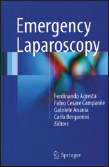Translate this page into:
Emergency Laparoscopy
Corresponding Author:
V Lekha
Department of Surgical Gastroenterology, Lakeshore Hospital and Research Centre, NH Bypass, Nettoor Kochi, Kerala
India
drvlekha@gmail.com
| How to cite this article: Lekha V. Emergency Laparoscopy. Natl Med J India 2018;31:185 |
Emergency Laparoscopy . Ferdinando Agresta, Fabio Cesare Campanile, Gabriele Anania, Carlo Bergamini. Springer, Switzerland, 2016. 253pp, price not mentioned. ISBN 978–3– 319–29618–0.

Even though there are a plethora of books and publications about elective laparoscopy and laparoscopy in general, not many books are dedicated to emergency laparoscopy. This book fills a void in the area of emergency laparoscopy for which the authors must be congratulated. It is true that most surgeons are comfortable doing laparoscopy in the elective scenario. However, they are hesitant to attempt laparoscopy in emergency situations especially trauma and peritonitis. This evidence-based book will encourage surgeons to attempt laparoscopy in emergency situations as well.
As the book is strictly based on evidence, it is ideal for postgraduate students as well as practising surgeons. The authors have done an extensive search of the literature to give up-to-date information on various clinical scenarios especially in the chapter on abdominal trauma. However, not many details are given of the technical and procedural aspects, and thus the illustrations are also few in number. At the same time, it is emphasized in every chapter that even though laparoscopy is feasible, the final decision is based on the experience of the surgical team and its comfort in performing laparoscopy in emergency situations. As the area of minimally invasive surgery is progressing rapidly, the contents should be updated frequently. No mention has been made anywhere in the book about the role of robotic surgery in abdominal emergencies. This is especially notable as initially robotic surgery was intended to treat emergencies in astronauts and also for doing surgical procedures in war zones keeping a skilled surgeon away from the battlefield.
Even though the authors have met their aim of providing evidence-based information about emergency laparoscopy, few errors and spelling mistakes have crept in especially in the last few chapters. Overall, this book is informative, evidence-based, with clear illustrations and should be available at every centre doing laparoscopic procedures. This will be useful for post-graduates preparing for examinations as well as practising surgeons, gynaecologists and even anesthesiologists and intensivists.
The appearance of the book is appealing but the cost is not mentioned anywhere on the book. It is suggested that the next edition should provide some detail about surgical techniques and tips with each chapter including a brief description of the operation theatre settings and instruments necessary for performing the procedures along with proper methods of disinfection.
Fulltext Views
928
PDF downloads
10,870




